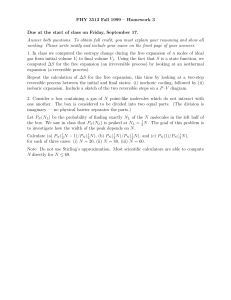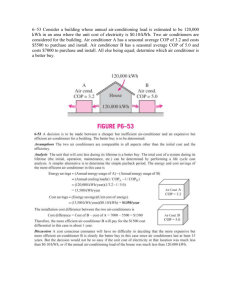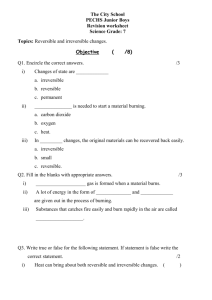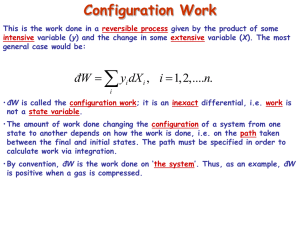Compression of an Ideal Gas as a Irreversible Processes*
advertisement
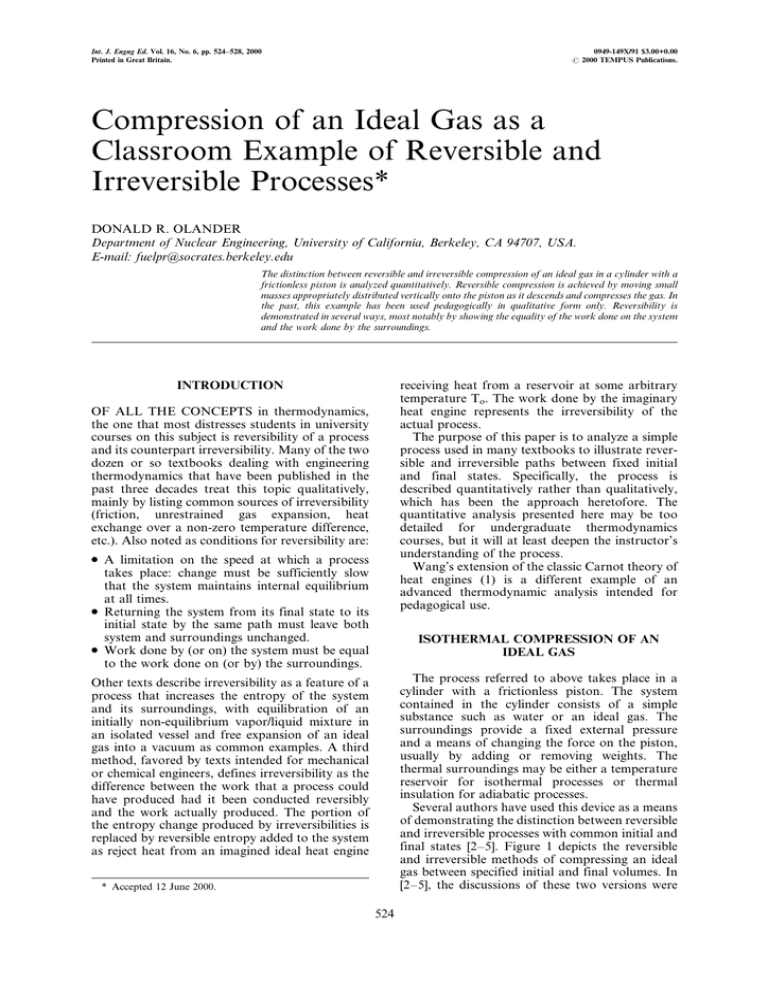
Int. J. Engng Ed. Vol. 16, No. 6, pp. 524±528, 2000 Printed in Great Britain. 0949-149X/91 $3.00+0.00 # 2000 TEMPUS Publications. Compression of an Ideal Gas as a Classroom Example of Reversible and Irreversible Processes* DONALD R. OLANDER Department of Nuclear Engineering, University of California, Berkeley, CA 94707, USA. E-mail: fuelpr@socrates.berkeley.edu The distinction between reversible and irreversible compression of an ideal gas in a cylinder with a frictionless piston is analyzed quantitatively. Reversible compression is achieved by moving small masses appropriately distributed vertically onto the piston as it descends and compresses the gas. In the past, this example has been used pedagogically in qualitative form only. Reversibility is demonstrated in several ways, most notably by showing the equality of the work done on the system and the work done by the surroundings. INTRODUCTION receiving heat from a reservoir at some arbitrary temperature To. The work done by the imaginary heat engine represents the irreversibility of the actual process. The purpose of this paper is to analyze a simple process used in many textbooks to illustrate reversible and irreversible paths between fixed initial and final states. Specifically, the process is described quantitatively rather than qualitatively, which has been the approach heretofore. The quantitative analysis presented here may be too detailed for undergraduate thermodynamics courses, but it will at least deepen the instructor's understanding of the process. Wang's extension of the classic Carnot theory of heat engines (1) is a different example of an advanced thermodynamic analysis intended for pedagogical use. OF ALL THE CONCEPTS in thermodynamics, the one that most distresses students in university courses on this subject is reversibility of a process and its counterpart irreversibility. Many of the two dozen or so textbooks dealing with engineering thermodynamics that have been published in the past three decades treat this topic qualitatively, mainly by listing common sources of irreversibility (friction, unrestrained gas expansion, heat exchange over a non-zero temperature difference, etc.). Also noted as conditions for reversibility are: . A limitation on the speed at which a process takes place: change must be sufficiently slow that the system maintains internal equilibrium at all times. . Returning the system from its final state to its initial state by the same path must leave both system and surroundings unchanged. . Work done by (or on) the system must be equal to the work done on (or by) the surroundings. ISOTHERMAL COMPRESSION OF AN IDEAL GAS The process referred to above takes place in a cylinder with a frictionless piston. The system contained in the cylinder consists of a simple substance such as water or an ideal gas. The surroundings provide a fixed external pressure and a means of changing the force on the piston, usually by adding or removing weights. The thermal surroundings may be either a temperature reservoir for isothermal processes or thermal insulation for adiabatic processes. Several authors have used this device as a means of demonstrating the distinction between reversible and irreversible processes with common initial and final states [2±5]. Figure 1 depicts the reversible and irreversible methods of compressing an ideal gas between specified initial and final volumes. In [2±5], the discussions of these two versions were Other texts describe irreversibility as a feature of a process that increases the entropy of the system and its surroundings, with equilibration of an initially non-equilibrium vapor/liquid mixture in an isolated vessel and free expansion of an ideal gas into a vacuum as common examples. A third method, favored by texts intended for mechanical or chemical engineers, defines irreversibility as the difference between the work that a process could have produced had it been conducted reversibly and the work actually produced. The portion of the entropy change produced by irreversibilities is replaced by reversible entropy added to the system as reject heat from an imagined ideal heat engine * Accepted 12 June 2000. 524 Compression of an Ideal Gas as a Reversible and Irreversible Processes 525 Fig. 1. Isothermal compression of an ideal gas. qualitative. The objective of the present paper is to quantitatively demonstrate the following features of the process: 1. In the reversible version, the work done by the surroundings is identical to the work done on the system. 2. The work done by the surroundings in the irreversible process is numerically compared to the work performed in the reversible process. In both cases shown in Fig. 1, a total mass M is added to the top of the piston. The only difference between the two methods is the way that the mass is placed on the piston's pedestal. In the reversible process, the mass M is divided into a large number N of small masses m such that M = Nm. The small masses are slid on to the piston one at a time from shelves at different elevations. In the irreversible version, the entire mass M is placed on the piston at once. In both cases, the cylinder contains n moles of and ideal gas and is immersed in a constanttemperature bath. The thermal reservoir removes heat as the small weights are added to maintain the gas at temperature T during the entire reversible process. In the irreversible process, only the initial and final states are at temperature T; these are equilibrium states of the gas whereas the state depicted in the lower middle panel of Fig. 1 is not. Reversible compression Sliding a small mass onto the pedestal causes the piston to very slightly compress the gas in the cylinder. Each addition of a small mass approximates an infinitesimal equilibrium stage so that the overall process is reversible. At all points in the compression process, the conditions of external equilibrium, namely: T Tsurr and p psurr jmg=A 1 are satisfied. In equations (1), Tsurr and psurr are, respectively, the constant temperature and constant pressure of the surroundings. The number of small masses added to the piston is denoted by j (0 j N), g is the acceleration of gravity, and A is the cross-sectional area of the piston. The p-V work done on the ideal gas during the reversible, isothermal compression from initial and final volumes Vo and Vf is: V0 V0 pdV nRT ln Wrev 2 V f Vf The work done by the surroundings consists of the sum of the p-V work on the piston by the external pressure and the loss to gravitational potential of the small masses: Wsurr psurr V0 Vf Ep 3 Ep is calculated by summing the changes in the potential energy of each small mass as it is slid horizontally onto the stack on the pedestal. Detailed calculation of Ep given in the appendix shows that Wrev = Wsurr, so a criterion of reversibility is satisfied for this process. In addition, the process can be reversed by sequentially sliding the small masses off the pedestal at their original elevations. When the initial state is recovered, exactly the same amount of heat that was released by the compression process will have been absorbed during the expansion process. Both system and surroundings will have been restored to their original states. 526 D. Olander IRREVERSIBLE COMPRESSION When the entire mass M is placed on the piston, as in the bottom of Fig. 1, the system is not in equilibrium with the surroundings. The piston rapidly descends, oscillates as the gas acts as a spring, and eventually settles down to the final elevation. Although equation (2) does not apply to this situation (because the process is not internally reversible), equation (3) does. In this case, the potential energy loss Ep is easily determined from the elevation change of the large mass, which is directly related to the volume change of the gas by h = (Vo ± Vf )/A. The work done by the surroundings in this irreversible process is: Wirr psurr Vo Vf Mg Vo Vf =A (Strictly speaking, the p-V work term in this equation does not apply because of internal irreversibililties in the atmosphere of the surroundings as the piston oscillates to its final resting position. However, the final results are a reasonable representation of the work done to the extent that pf > psurr .) At the final equilibrium state, the force balance on the piston gives: pf psurr Mg=A Combining these two equations and using the ideal gas law yields: V0 1 Wirr pf V0 Vf pf Vf Vf V0 nRT 1 4 Vf Comparing this equation with equation (2) for Vo/Vf = 3 (as an example) shows that the ratio of the reversible work of compression to the irreversible work is: Wrev ln 3 0:55 Wirr 3 1 That is, the surroundings need to supply only about one half as much work for the reversible process as it does for the irreversible process. Finally, simply sliding the large mass off the piston in the final state in the lower portion of Fig. 1 returns the system (gas plus piston) to its initial state but leaves the surroundings with the large mass at a lower elevation than it was initially. Both of these consequences are characteristic of an irreversible process. CONCLUSIONS Reversible compression of an ideal gas in a piston-cylinder apparatus by the distributed weight method has been analyzed quantitatively. The objective was to add an analytical structure to this often-used pedagogical tool to aid students in thermodynamics courses to better grasp the concepts of reversible and irreversible processes. For the reversible compression process, the equality of work done on the system with that done by the surroundings is demonstrated. The ratio of the reversible and irreversible work requirements for the isothermal version of the process is determined as a function of the compression ratio. REFERENCES 1. Liqiu Wang, Carnot Theory: Derivation and Extension, Int. J. Eng. Educ., 14, 6, (1998) p. 426. 2. H. C. Van Ness, in Understanding Thermodynamics, (Dover, ed.) (1984) pp. 19±21. 3. M. M. Abbott and H. C. Van Ness, Thermodynamics with Chemical Applications, 2nd Ed., McGraw-Hill (1989) pp. 6±9. 4. G. Van Wylen, R. E. Sonntag and Claus Borgnakke, Fundamentals of Classical Thermodynamics, 4th edn., Wiley (1994) pp. 200±201. 5. A. Shavit and C. Gutfinger, Thermodynamics, Prentice-Hall (1995) pp. 23±25. APPENDIX Proof of the Identity of Wrev and Wsurr . Piston displacement on adding small weights. With no weights on the pedestal, and neglecting the masses of the piston and the pedestal, the initial volume Vo is given by the ideal gas law: Vo nRT=psurr A1 Compression of an Ideal Gas as a Reversible and Irreversible Processes 527 When j small weights of mass m have been added to the pedestal, the pressure in the gas is given by equation (1) of the text and its volume is: V nRT nRT p psurr jmg=A A2 Downward displacement of the piston after j weights have been added is: Vo V nRT 1 Vo 1psurr 1 xj A A psurr jmg=A A 1 1 j A3 where mg Apsurr A4 . Potential energy loss due to adding weights to the pedestal. The small masses are placed on shelves spaced vertically according to equation (A3). From these shelves, they can be slid horizontally onto the pedestal when the latter reaches the appropriate height. When the first weight is added to the pedestal, the loss of potential energy (PE) is mgx1. When the second weight is added, the first weight drops to height x2 and the second weight (which is slid on to the pedestal at height x1) loses PE by an amount mg(x2 x1). Addition of the third weight at height x2 causes weight #1 to experience a cumulative PE loss of mgx3, weight #2 has a cumulative loss of mg(x3 ± x1), and weight #3 experiences a PE loss of mg(x3 x2). After N weights have been moved from their shelves to the pedestal, the total potential energy loss of the distributed mass M is: Ep mg N X xN xj 1 NmgxN mg N X j1 xj A5 1 j1 where, using equation (A4): N X xj 1 N X1 j1 j0 X1 Vo N xj 1 A j0 X1 1 Vo N Vo N A j0 1 j A 1 N X1 j1 1 1 j ! A6 is very small (because m is small), and N is very large, so that the product N is of order unity. Therefore, the sum in equation (A6) can be approximated by an integral: N X1 j1 1 1 j N 1 dj ln1 N 1 j 1 ln1 N A7 Combining equations (A5)±(A7) and using N 1 gives the total PE loss of the distributed weights: Vo ln 1 N Ep NmgxN mg N A8 A . Work done by the surroundings on the system. Dividing equation (A2) for j = N and V = Vf by equation (A1) gives: Vf 1 Vo 1 N Substituting equation (A8) into equation (3) of the text and using equation (A9) yields: Vf Vo ln 1 N Wsurr psurr Vo 1 N NmgxN mg Vo A A9 A10 Substituting equation (A9), expressing mg in terms of using equation (A4), eliminating psurr using equation (A1), and xN from equation (A3) simplifies equation (A10) to: Wsurr nRT ln 1 N A11 528 D. Olander Finally, substituting equation (A9) into (A11) yields: Wsurr nRT ln Vo =Vf which is identical to Wrev given by equation (2) of the text. Donald R. Olander is a professor of nuclear engineering at the University of California at Berkeley. He obtained his BS degree in chemical engineering from Columbia University in 1954 and his ScD from the Massachusetts Institute of Technology in 1958. He has been a member of the faculty of UC Berkeley since 1958. His research deals with the behavior of fuel element materials of reactors in both normal and severe accident conditions, on which he has published over 200 papers. He is a Fellow of the American Nuclear Society and has received from the Materials Science and Technology Division of the Society the Award for Outstanding Contributions to Nuclear Technology for his book Fundamentals of Nuclear Reactor Fuel Elements in 1976 and the Division's Twenty-Five Year Award in 1996. He is the recipient of the Sustained Outstanding Research Award in Materials Chemistry from the USDOE Office of Basic Energy Research in 1983. He was also the recipient of the Fellowship of the Japan Society for the Promotion of Science for a lecture tour in 1983, the National Science Council (Taiwan) Lectureship in Nuclear Engineering in 1987 and the Lady Davis Visiting Professorship at the Technion, Israel, in 1988. In addition to serving as a consultant to the Electric Power Research Institute on extended burnup of LWR fuels and to the Westinghouse Hanford Co. on disposition of DOE spent nuclear fuels, Professor Olander has served on the Design Review Committee for the Modular Accident Analysis Program (MAAP) severe accident code and on the review committee on In-Vessel Coolability and Retention of a Core Melt for the US DOE. He was a member of the Review Team for the Atomic Vapor Laser Isotope Separation (AVLIS) program for the US Enrichment Corporation. He also consults for Duke Engineering Services (Hanford) on treatment of N-reactor spent fuel. A special issue of the Journal of Nuclear Materials (April 1999) was prepared in his honor by his colleagues and students in the field of nuclear materials. He is a member of the National Academy of Engineering. A12


